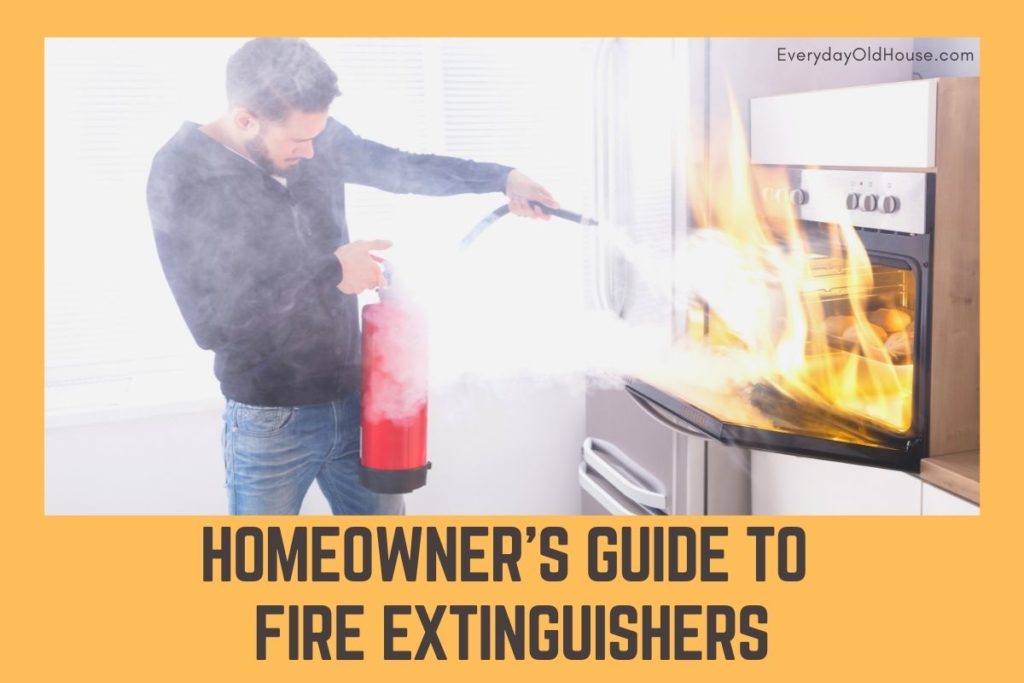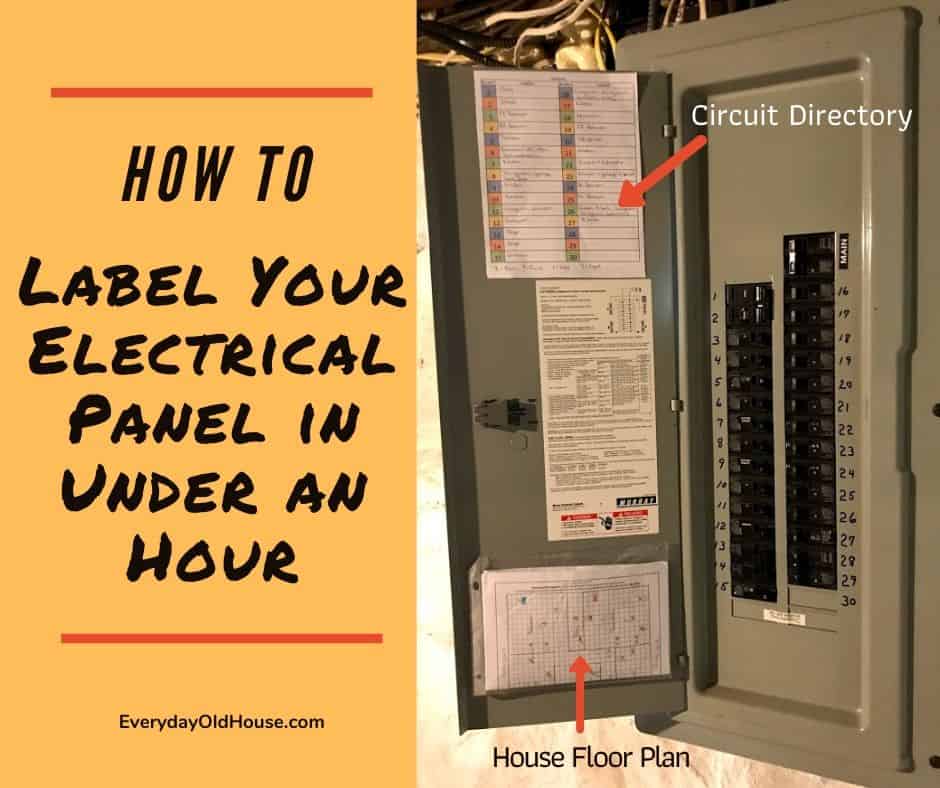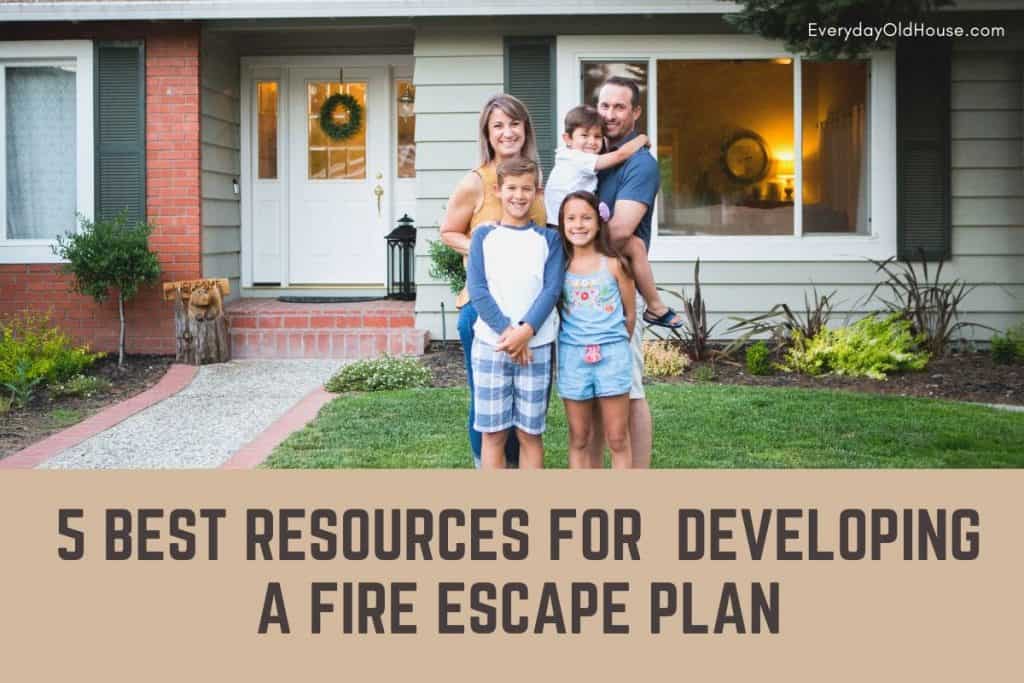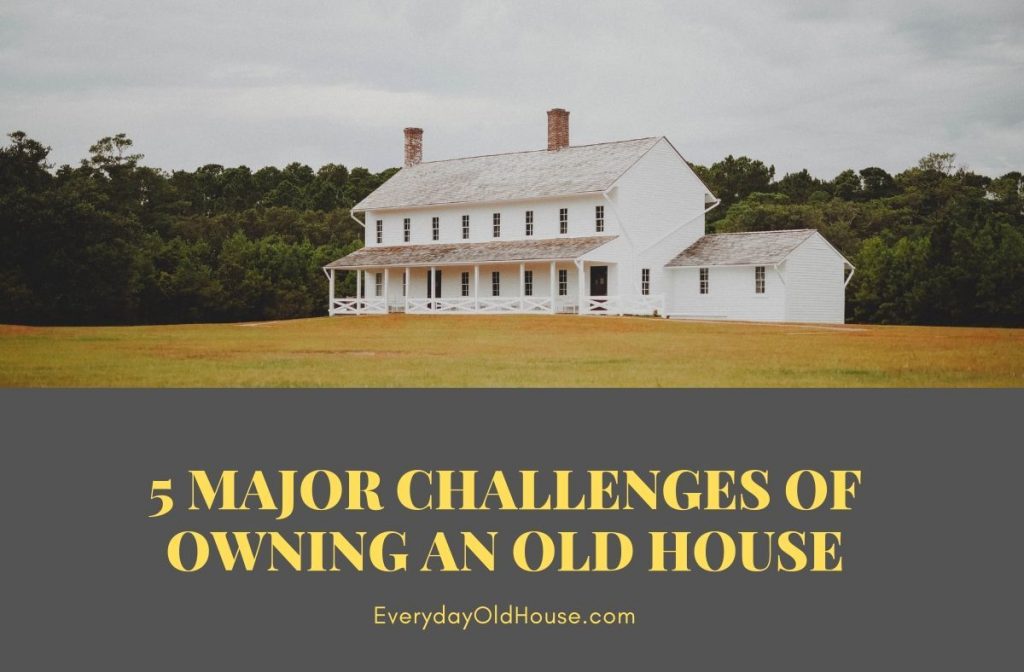House fires are unexpected, unpredictable and can quickly spiral out of control in both new and old houses. And once a house burns, it’s changed forever. And restoring an old house’s charm and uniqueness can be a long, costly challenge. To protect your old house from the risk of fire, here’s what you need to know about why old houses are more likely to catch fire.
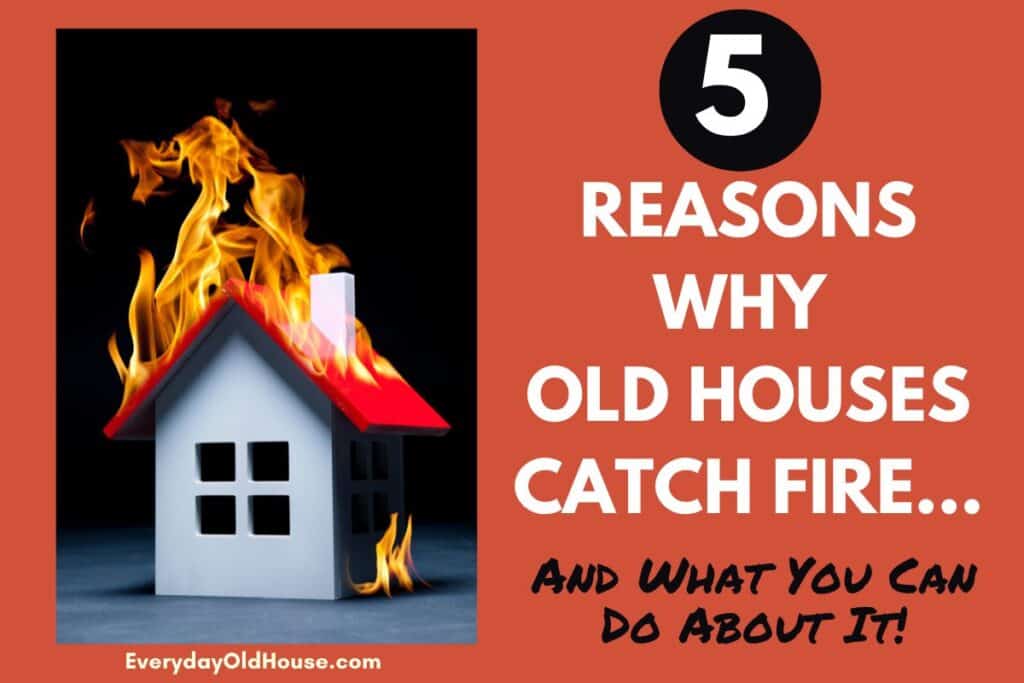
This post contains affiliate links, including but not limited to, Amazon Associates. As such, I earn from qualifying purchases. Full disclosure located here.
Common Causes of Fire in ALL Homes
Before I dive into the additional reasons why old houses are at risk for fire, let’s set the baseline with the most common causes of fires for ALL homes, new and old.
Every year in the United States there are about 350,000 house fires with over 2,600 deaths and 11,000 injuries (NFPA). Those numbers are a lot higher than I anticipated.
The figure below shows the leading cause of home fires, deaths and injuries.
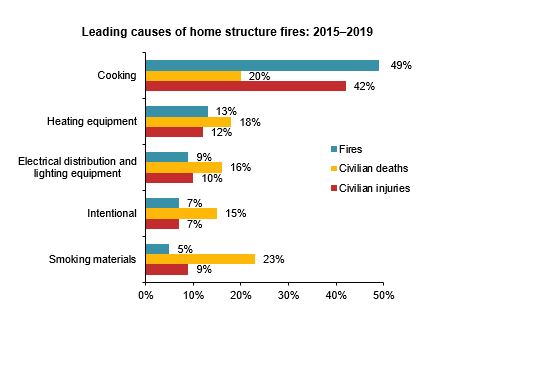
Surprisingly, cooking tops the list for fires (50%!) and injuries (42%)! However, interesting to note is that smoking is the 5th leading cause of home fires (only 5%), but the number 1 cause of deaths (23%).
If interested, you can dive further into causes of fires, deaths and injuries in NFPA’s detailed report.
Take-Away
There are reasons why older houses have a higher risk of fire BUT what I want you to also take away from this post is this:
Most home fires, injuries and deaths is from human use, not from age or physical characteristics of your home.
For example, the top 3 causes of home fires – cooking, intentional and smoking, which combined account for 60% of house fires – relate to homeowner habits. Not to old, worn out building components.
What does that mean to you?
While it is important as a homeowner of an older house to understand the additional risks to your old house, it is even MORE important to practice general fire prevention and safety.
How can you practice fire prevention in you home? Create and practice a fire escape plan. Check your fire extinguisher. Test the batteries in your smoke alarms.
5 Reasons Why Old Houses Are More Likely to Catch on Fire
Now that we have discussed the top reasons for all houses – young and old – catch fire, let’s dive down into the subset of reasons why old houses are more likely to catch fire compared to new builds.
Older houses are more vulnerable to catching on fire from these 5 causes:
- Faulty Electrical
- Poorly Handled Renovations
- Compromised Chimneys
- Demographics
- Balloon Frame
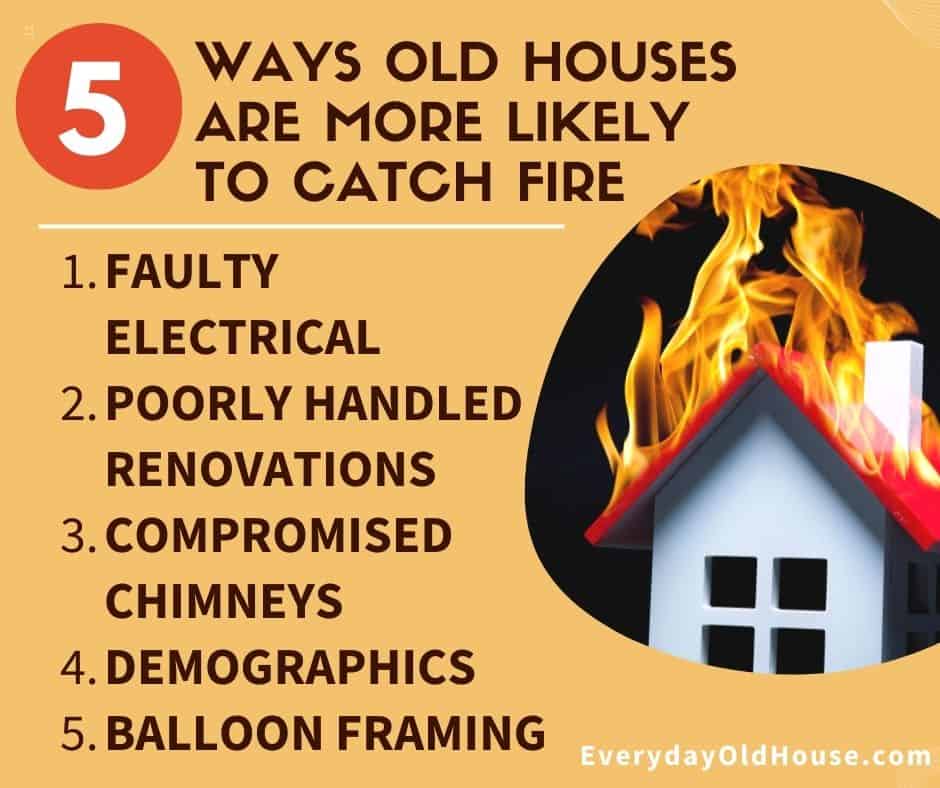
1. Faulty Electrical
Electrical failure or malfunction is the third leading cause of fires for all houses, new and old. However older homes possess an even higher risk of electrical fires.
When a home’s electrical system is overburdened, there is an increase in “arc faults”. In simple terms, arc faults are the unintentional jumping of electricity between metal points of an electrical distribution system, causing sparks. This results in heating up of wires to the point of producing enough heat to ignite a fire.
Arc faults happen for a few reasons, including:
- Outdated Electrical System
- Worn-out Wires
- Overused Extension Cords
Outdated Electrical System
Electrical systems of older homes were originally built to handle a lot less amps than today’s needs. For example, older homes had as little as 30 amp, compared to most homes today needing 100 to 200 amps (and sometimes that still isn’t enough).
Even with electrical upgrades throughout the decades, the ever-increasing power demand of today’s electrical needs places a significant strain on a home’s wiring and electrical system.
Between old electrical systems (like knob and tube or other non-grounded systems) or shotty piece-meal upgrades from previous decades, your home might not have the wiring capacity to handle today’s electrical intensive household with computers, air conditioners, large tvs, etc.
Wear & Tear
Another causes of fire in old homes from electrical malfunctions is merely due to natural wear and tear. Over time, parts of the electrical system deteriorate or become damaged, making it vulnerable to catching on fires.
Not only does this apply to the actual home’s wiring, but also to old appliances like dishwashers and refrigerators.
Overused Extension Cords
The reality of many old homes (like mine) is there isn’t enough electrical outlets in each room. And you find yourself with multiple extension cords and power strips so that you can increase outlet capacity from 2 plugs to 6.
For example, a large-screen tv, video game console, home theater speakers, and computer all plugged into a power strip that connects to ONE single outlet.
One of the reasons old houses are more likely to catch fire is that electrical circuits are overloaded from the demand of too many plugged-in electrical devices and appliances from extension cords. Especially around the holidays.
Learn more about your home’s electrical system here.
What Can You Do?
Since a significant portion of the electrical system is hidden behind walls, it is difficult to know the exact condition of your electrical distribution system. Sure your circuit breaker might be up to date, but how confident are you that ALL the wiring behind the walls was replaced? And were those electrical upgrades done properly and up to current building codes?
While there are aspects of a home’s electrical system that are difficult to assess, there are a few things you can do to lower your risk of electrical fires in your old house:
- Watch for Signs
- Be Mindful
- Install Circuit Interrupters
Watch for Signs
Your home can give you some signs of hidden electrical issues, such as:
- Circuit breaker frequently overloaded
- Flickering lights
- Appliances or electrical devices that feel excessively hot
- Shocks or sparks from appliances or outlets
- Unexplained burning smells
Be Mindful
Reduce the risk of fire by taking it easy on your outlets. First, map your main circuit breaker and create a directory to gain and understanding of overloaded circuits.
In mapping our home’s circuits we learned that half of our second floor connects to the SAME circuit. So come summer when we install our window air conditioners, we use an outlet that isn’t connected to that particular circuit.
If you must use power strips and extension cords (which let’s face it with old houses, you do), use with caution. Pick the right equipment appropriate for its intended use and rated high in safety. Be mindful of how many devices and appliances you are plugging into each outlet.
Other electrical safety tips include:
- Don’t run an extension cord beneath carpets
- Never install light bulbs that exceeds a fixture’s maximum recommended wattage
- Repair or replace loose outlets
- During the holidays, be careful plugging in all those holiday lights, the most dangerous time of the year for house fires.
Install Circuit Interrupters
The NFPA recommends the installation of devices, such as an arc-fault circuit-interrupters (AFCI’s) and ground-fault circuit-interrupters (GFCI’s) to monitor how electricity moves throughout your home.
These interrupters notice abnormal activity and immediately interrupts the circuit, reducing the risk the fire.
Installation is NOT a DIY project since it involves working with the circuit breakers. Hire a qualified electrician to do the installation.
2. Poorly Handled Renovations
Another reason why old houses are more likely to catch fire is from renovations. The biggest triggers of fire in older homes under renovation include heating equipment (especially space heaters), faulty electrical, cooking equipment, and contractor’s tools. For example:
- Contractors use torches, soldering iron, and other shop tools that work with open flames. Misuse of these tools can create sparks, or overheat and ignite combustible materials.
- Homeowners and contractors use space heaters to stay warm during a winter renovation. Or using less-than-ideal appliances such as hot plates to cook meals during a kitchen renovation.
- Renovations of old houses commonly include opening up old walls and updating old electrical wiring. And depending on how old the electrical system, there is a chance of faulty, ungrounded outlets, overloaded circuits, and outdated and worn-out wires (like knob and tube).
What Can You Do?
There are a two things that homeowners can do to decrease the risk of fire during renovations: hire the right contractor, and renovate with quality building components.
Hire the Right Contractor
First, seek out a contractor with an understanding of older houses and who maintains a high fire-safety culture. When vetting out contractors, stress the importance of fire safety to your project.
Before signing a contract, make sure your contractors are properly insured and have no criminal records. While the work is being done in your house, supervise contactors while working when possible.
And sometimes you hire a careful contractor, but sometimes honest accidents happen from using tools like heat guns, like in the photo below.

Don’t Replace with New
This second factor won’t change the risk of fire during the renovation. But it will definitely impact how fire-safe your home will be in the future.
Research has shown that old houses, constructed with natural materials and wood, takes longer to burn than newer construction. In fact, about 35 years ago, the average house gave occupants about 17 minutes to escape once the smoke detector sounded.
Now, the average house has a safety time of 2 minutes.
Crazy, right?
New houses tend to burn faster for a variety of reasons, including building materials. For example, particleboard burns quicker than natural wood.
When choosing new materials to replace the old, don’t lose the extra fire protection of your old house by replacing with modern materials. Sure, particleboard may to save money and effort over natural wood, but you lose precious minutes for your family to escape in a house fire. Consider natural wood floors over vinyl. Rely on your contractor to help you choose building materials that will keep your home safe and give you peace of mind.
3. Compromised Chimneys
Chimneys and wood stoves are another risk. As you would expect, most home heating fires occur during the winter months, with almost 50% during just 3 months (January, February and December).
And the leading cause of home heating fires? Homeowners failing to upkeep and clean heating equipment, especially chimneys.
Poorly maintained chimneys create an environment ripe for fires.
First, combustion of fuel in chimneys naturally creates a byproduct buildup of tar, ashes and soot called creosote. Not only can this buildup prevent it from properly venting, it can also cause a dangerous chimney fire.
Second, chimney flue linings break down over time as it is exposed to moisture and creosote. Eventually the flue’s lining breaks or cracks, making your home can be more susceptible to fire.
What Can You Do?
To lower your risk of home heating fires, have a professional annually inspect and clean your chimneys and woodstoves.
Ensure there is no obstructions (plants, animals) creating blockages in the chimney. Install a liner (some old chimneys don’t even have one) or have your chimney flue re-lined when needed. Check for damage to the masonry, mortar as well as chimney caps.
To help you remember, add this task to your fall home maintenance list. And while you at it, schedule preventative maintenance of the rest of your home heating system, including furnaces and boilers.
4. Demographics
Older houses are more likely to catch fire than the average home just due to certain demographics. First, older houses tend to be located in lower-income and minority neighborhoods, which statistically puts them at greater risk of fire.
Second, a hefty percentage of old houses are owned by the elderly. Unfortunately, older folks are usually constrained by mobility issues that preclude them from doing their own home maintenance. And many retirees are also financially limited with a set income, precluding them from hiring contractors to maintain the home. These factors create a situation of old houses with deferred maintenance and a greater threat to fires.
What Can You Do?
If you happen to be part of these demographics, your best plan is a good defense.
Ensure you have visible house numbers so the fire department can find your house in an emergency. Ensure you have strong fire prevention plan. It is essential that everyone in the household understand escape routes from your home. Ensure everyone in the household knows what to do in case of a fire. For example, designating a meeting spot where everyone meets upon leaving the house.
In addition to a fire escape plan, check your fire extinguisher. Change the batteries in your smoke alarms.
For older homeowners, plan for abilities and address mobility tips. Older homeowners are less able to escape a house fire due to physical and mental limitations. Due to reduced hearing, older folks may not even hear the smoke alarms to know to evacuate. By age 65, people are 50% more likely to be killed or injured by fires. By age 85, the risk of dying is more than 250% percent higher.
5. Balloon Framing
OK, so admittedly this isn’t exactly a cause of increased fires in old houses. BUT if an old house has this type of framing, it can be an aggravating factor in creating more devastation and damage. So I felt it important to still include….
In general, there are 3 main types of house frames in the United States: timber, balloon and platform. And if your house has a balloon frame, it is at higher risk for a catastrophic fire.
Balloon framing was the most common form of house construction in the United States between 1880s to 1930s. It post-dates the timber framing, which was a post- and beam- construction using heavy timber beams and columns joined by mortise and tenon connectors. Walls were non-load bearing, the weight of the structure was supported by the timber frame. Timber framing was labor-intensive, using heavy timbers and connecting joints that took time and skill to create.
Then balloon construction came on the scene and quickly grew in popularity, since it more efficient, cheaper, and easier to build. In this construction method, the walls take on load-bearing responsibilities, with floors sitting on the walls. Wood framing from the foundation to the rafters, with no breaks between floors.
As pictured below, it’s like a series of chimney flues around the exterior walls of your home. [BTW to learn more about balloon framing, check out Construction Physics where I found most of this information.]

And that space between floors is what can cause a catastrophic fire. Once flames get into the walls, there’s nothing to stop flames from a fire that starts in the basement to the roof in seconds. Some firefighters call this the “chimney effect”.
Now, to be clear, balloon framing does not increase the risk of a fire starting. But this design does drastically increase the chance for catastrophic results if a fire starts.
Luckily, by the 1930s platform framing replaced balloon framing as the predominant construction building method for a few reasons, including increased fire safety.
What Can You Do?
If your old house has balloon framing (which admittedly is hard to determine), create fire breaks by retrofitting the walls. A common solution is installing spray foam insulation inside the exterior walls. While this home improvement can be expensive, it can also be a life saver to your home and your family.
Once a Fire Starts in an Old House
Timothy McConnell (Superintendent and 35-year veteran of the New Orleans Fire Department) advised New Orleans Preservation in Print that once a fire starts in an old house, there are challenges to firefighters to quickly and effectively fighting a fire. He mentioned that older buildings not up to modern codes pose additional risks that hinder putting out a fire such as “decay, structural instability, improper alterations that may be hidden, etc…”
He stressed the importance of homeowners to understand the responsibilities involved with the maintenance and modernization of an older building. Homeowners need to recognize 1) when it’s necessary to upgrade outdated heating, electrical, and plumbing systems, and 2) ensure that these upgrades are renovated in accordance with safety codes.
Wrapping It Up
House fires can be devastating, and in many cases, deadly. While the majority of house fires are related to human use (i.e. cooking, intentional, smoking), there are characteristics of old houses that make them more likely to catch fire. Luckily, there are a few things that owners of old houses can do to prevent fires and protect the unique charm and history of their homes.
Related Posts
Want to be the first to know about new posts? Be sure to follow me on Pinterest, Facebook, Instagram or Twitter of even Etsy! Or better yet… Subscribe below!
My monthly (admittedly sometimes more, sometimes less….) emails are like receiving a unexpected letter from an old friend WITHOUT needing to put on your slippers and walk out to your mailbox…. See? I got ya, my friend!)
[Note: My posts are proudly connected to these amazing link parties full of DIY ideas and inspiration!]
